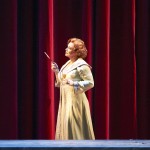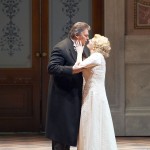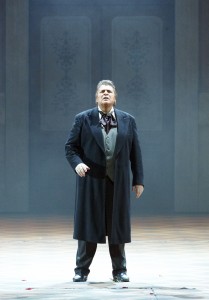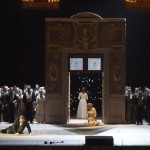

 Vienna State Opera’s latest staging of Wagner’s Tannhäuser premiered in June 2010.
Vienna State Opera’s latest staging of Wagner’s Tannhäuser premiered in June 2010.
I was fortunate to experience new MD Franz Welser-Möst conducting a stellar cast, including Johan Botha as Tannhauser, and Christopher Gerhaher as Wolfram. So, my expectations were not great for Bertrand de Billy. After all, how can a Frenchman -even as distiguished as de Billy (Chief Vienna RSO 2002-2010)-compare with an Austrian, Welser-Möst, conducting Wagner? (In fact, de Billy debuted with Vienna State Opera in 1997, and has also conducted Fidelio, La Traviata, and Don Carlo this season.)
My expectations were exceeded and shameful prejudices were confounded. This was an exceptional performance which illuminated Wagner’s complex, mystifying, and at times mystical work. De Billy’s was a no-nonsense, rational approach to Wagner- eschewing the grandiose, and the thickening of Wagner’s orchestral textures with vibrato. I saw Christian Thielemann conducting The Ring (Siegfried)- Thielemann a massive presence, lounging luxuriantly, half-seated. De Billy, very slim and youthful , dressed in a business-like dark suit, was always standing, nimble, alertly responsive to his Vienna players. He’s modern and unpretentious. And de Billy goes for clarity, cutting through Wagnerian obfuscation.
First experiences of Wagner’s Tannhauser are of a work of infinite complexities. One cannot ever hope to fully understand it. I was at first too overwhelmed by the music, to really understand the ‘plot’, or come to terms with the work.
Tannhauser is the archetypal (nineteenth century) Romantic cult figure, hero and anti-hero, fraught by passionate emotions and longing; and ultimately consumed by conscience to face (problematically) a religious conversion, his soul redeemed. In the opening Act, he descends from Venusberg (Venus’s mountain), to confront Elisabeth, his betrothed, and to whom he’s been unfaithful. Act 2 puts Tannhauser – the Romantic outsider- in a wider social context. Tannhauser is measured up by the Landgrave (Elisabeth’s uncle). And he has to take part in a ‘Song contest’, where traditionally the men extol love as pure and chaste. Tannhauser, still intoxicated by Venus’s charms, antagonises his hosts by arguing love as pleasurable and licentious. Tannhauser’s life is saved by Elisabeth’s intervention. But he must serve penance, and is sent on a pilgrimage. The third Act shows Tannhauser still torn between the Spiritual and the Flesh, on his sickbed. He’s visited by Pilgrims, but still obsessed with the memory of ‘Venus’. Only Elisabeth’s devotion and love can persuade him to a religious conversion. Like Gounod’s Faust, the closure sweeps us up in a climax of religiosity. But whereas Gounod’s was Christian – the mid-19th century zeitgeist – Wagner’s is rather psychological/ spiritual, orgasmic love in death.
Claus Guth’s (controversial) sets are creative and imaginative in locating these scenes in late 19th century Vienna. How to convey the idea of Venusberg, if not as a bordello, or smart pick-up hotel as in Guth’s set? Act 2, using a re-creation of Vienna Staatsoper’s reception/foyer for Wartburg is witty, a self-reflexive mirror of (Viennese) Society. And Guth’s set uses Otto Wagner’s Hospital in Act 3 -as if Tannhauser were an inmate of a (progressive) mental asylum. Tannhauser’s state of mind is rather a sickness of the soul- a man consuming himself in his own passions and guilt. But Tannhauser has also revolted against decency, the mores of the time. His free-love, craving sexual appetite is revolutionary.
Nevertheless, the strength of de Billy’s production is in the casting of Peter Seiffert as Tannhauser. And its high point is in Act 3, in Seiffert’s depiction of Tannhauser as a soul in torment, and in conveying the power of his religious redemption. It is convincing in its spirituality.
 Seiffert as Tannhauser is a triumph. Highlights are, in Act 2, Tannhauser’s confession of his deeds, when he staggers, quaking, at the mercy of the Wartburg Assembly.( Elisabeth intercedes; she will be his judge.) With Seiffert, it all erupts, catches fire, in the marvelous choral singing of the climax to Act 2. Tannhhauser ‘cannot contradict heaven’s will’. He is sent on a pilgrimage- backed by a terrific ensemble and chorus, women’s choir behind him- ‘to Rome!’
Seiffert as Tannhauser is a triumph. Highlights are, in Act 2, Tannhauser’s confession of his deeds, when he staggers, quaking, at the mercy of the Wartburg Assembly.( Elisabeth intercedes; she will be his judge.) With Seiffert, it all erupts, catches fire, in the marvelous choral singing of the climax to Act 2. Tannhhauser ‘cannot contradict heaven’s will’. He is sent on a pilgrimage- backed by a terrific ensemble and chorus, women’s choir behind him- ‘to Rome!’
Seiffert is well up to the part. Act 1 demonstrated the technical power of his tenor. But Seiffert has reserves of passion – perhaps unsurpassed- to play the Romantic hero. He really acts, has the measure of Tannhauser. Seiffert sits curled up in a sort of purple dressing gown. He’s crushed with bitter anguish , bemoans having felt such evil lusts, tarrying in Venusberg. Seiffert slumped, making the sign of the cross; now jumps up, remembering Venus’s charms. But, his conscience asks, ‘Madman whom are you calling?’ Elisabeth enters; he’s drawn back to her. But he’s lost all hopes of salvation…But Wolfram assures him, an angel, (Elisabeth), has prayed for his soul, Tannhhauser hears the eternal voices.
Seiffert walks forward towards the audience , his hands raised, his face transfixed. And collapses. The choir of black-dressed pilgrims are behind Tannhauser’s bed – to suggest a religious vision. His soul has risen.
The climax – the religious revelation- was all consuming ; as if Bertrand de Billy had been reserving Vienna State Opera Orchestra’s very considerable power for an almighty surge. Chorus was thrilling, as throughout. Seiffert was ‘grossartig‘ (magnificent).
The whole production exceeded all expectations. As Wolfram Ludovic Tezier’s baritone is elegant, distiguished; and powerful. Tezier is beautifully poised in Act 2’s ‘debate’, rhetorically, ‘Can you fathom the nature of love?’ (Wolfram advocates platonic love; but must suffer Elisabeth betrayed by his friend Tannhauser.)Tezier is also excellent (beginning Act 3) in Wolfram’s summing up, and later reassuring Tannhauser of Elisabeth’s dedication.
Petra Maria Schnitzer (soprano) as Elisabeth has a pathos and simplicity to her voice. She sings ‘from a heart that has never betrayed’. In her dramatic Act 2 intervention saving Tannhauser, she’s perhaps a little under-powered. But she is particularly affecting in Act 3 , in the opening, over Tannhauser’s bed, offering her faith.
Swedish soprano Irene Theorin was impressively alluring as a voluptuous Venus.
Vienna State Opera Chorus were tremendous in the ensembles. And of course for the rousing Pilgrim’s Song (Act 3), made especially moving as the ‘pilgrims’ merge with nurses, doctors, and ‘inmates’ outside.
22.03.2012
Photos: Peter Seiffert (Tannhauser); Irene Theorin (Venus); Peter Seiffert and Petra Maria Scnnitzer (Elisabeth)
(c) Wiener Staatsoper/ Michael Pöhn
viennaoperareview.com
Vienna's English opera blog
